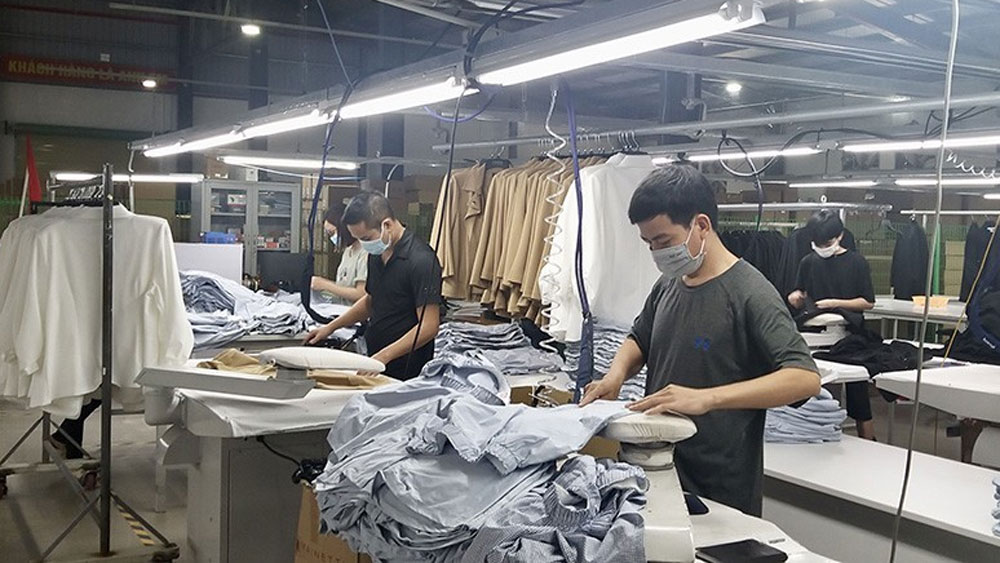Finding solutions to attract green capital
At the United Nations Climate Change Conference 2021 (COP26), Vietnam pledged to bring net emissions to “zero” by 2050. To achieve this goal, the World Bank estimates Vietnam will need about 380 billion USD. Therefore, Vietnam is actively implementing a roadmap to amend and supplement the legal framework to mobilise green finance and green technology, as well as encourage green production, investment and energy transformation towards a low-carbon and circular economy.
 |
|
Greening the production chain is an inevitable need that textile enterprises are forced to comply with. |
The inevitable trend
Vietnam is one of the countries attracting a lot of green capital from the world. More than 7 billion USD of foreign capital was poured into Vietnam in 2021 and 2022, mostly for green projects, to reduce harm to the environment and limit emissions.
According to Deputy Minister of Planning and Investment, Nguyen Thi Bich Ngoc, the shift towards green economic development is an inevitable trend. The country aims to pursue the development orientation following the Resolution of the 13th Party Congress, the 5-year socio-economic development plan in the 2021-2025 period and the 10-year socio-economic development strategy in the 2021-2030 period, while turning Vietnam into a pioneer of the region in green growth and catch up with the new development trend of the world.
Vietnam has been actively implementing a roadmap to amend and supplement the legal framework to mobilise green finance and green technology, to shift to a circular economy with low carbon emissions. In the report on “Vietnam financial market 2022 and outlook 2023”, experts from the Asian Development Bank (ADB) and the Joint Stock Commercial Bank for Investment and Development of Vietnam (BIDV) said that mechanisms and policies for the green financial market in Vietnam are being gradually improved in each type of instrument, such as green-society-sustainable bonds (GSS), green stocks, carbon markets, and green credit.
The report also states that green finance is a major trend worldwide, with the participation of international financial institutions, governments, and financial systems, in each country and region. Vietnam is no exception as the country is implementing a green growth strategy and witnessing rapid growth in the green financial market over the years.
The green financial market in Vietnam has seen positive results. Some Vietnamese enterprises have initially attracted green bond capital in the international market, while credit institutions have actively approached international sources of capital for green credit and promulgated internal regulations on the green credit framework.
“In the future, Vietnam promises to be an attractive destination for international green capital with an improved legal environment, while financial institutions and businesses are also making efforts to promote the circular economy and green finance, to mobilise resources for development investment and international integration for sustainable development,” according to ADB and BIDV.
Completing the legal framework
The legal environment is relatively open for green financial products in Vietnam and facilitates businesses to mobilise domestic and international green capital. However, according to many economic experts, the implementation of green credit and green bonds, under the new provisions of the Law on Environmental Protection 2020, is still waiting for more detailed instructions.
In addition, an assessment from the Vietnam Confederation of Trade and Industry (VCCI) also shows that the legal framework for green growth is increasingly being improved at the central level, but at the grassroots level is still in the preliminary stage. The development and promulgation of complete and synchronous sets of criteria are essential to assist localities in selecting and evaluating potential investors and projects, using high technology and environmentally-friendly technology, especially in the fields that Vietnam prioritises for development.
In addition, the level of understanding of environmental regulations of Vietnamese enterprises is still limited, with only 31% of domestic private enterprises grasping environmental regulations. Only about half of enterprises in energy-intensive sectors such as manufacturing, transportation, and construction have invested in innovation and application of energy and resource-saving solutions.
Therefore, Dr. Can Van Luc, Chief Economist of BIDV and Director of BIDV Training and Research Institute, proposed main groups of solutions to develop green finance in Vietnam, including the acceleration of the completion of mechanisms and policies, including a sandbox for new business models and the promotion of the development of green bond, green stocks and green credit markets. He also suggested the development of criteria and standards for green securities and green credit for consistent application by entities.
For the carbon credit market, it is necessary to complete the carbon credit exchange, trading products, market members and trading brokers, among others. It is also advisable to develop technology infrastructure, data, secondary markets and even derivatives for these green products in the long term while promoting communication to raise awareness and action in the field.
Deputy Director of Banking Strategy Institute Pham Minh Tu also suggested it is necessary to have a broader definition of green growth and orientation towards greening the economy, not only green credit, especially when the banking industry is in strong digital transformation, with many operations and products being 100% digitised. Although green growth is a general trend, it is important to study more about models such as the establishment of specialised green banks or green investment funds, which are channels to absorb all capital flows, serving green growth and the organisation of green projects.
Source: NDO
 Bắc giang
Bắc giang














Reader's comments (0)